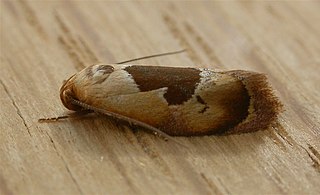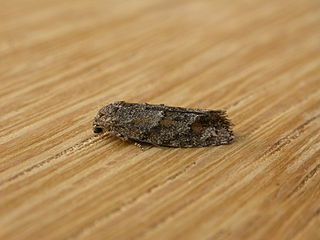Related Research Articles

Hoplomorpha camelaea is a moth in the family Oecophoridae first described by Edward Meyrick in 1888. It is found in Australia, where it has been recorded from Victoria, Queensland, New South Wales and the Australian Capital Territory.

Agriophara nodigera is a moth of the family Depressariidae. It is found in Australia, where it has been recorded from Queensland.

Eupselia satrapella is a species of moth of the family Depressariidae. It is found in Australia, where it has been recorded from Queensland, New South Wales and the Australian Capital Territory.

Euchaetis iozona is a moth of the family Oecophoridae. It is known from New South Wales, South Australia, Western Australia and Victoria.
Criophthona trileuca is a moth in the family Crambidae. It is found in Australia, where it has been recorded from Western Australia.
Metasia aphrarcha is a moth in the family Crambidae. It was described by Edward Meyrick in 1887. It is found in Australia, where it has been recorded from Western Australia.
Metasia hilarodes is a moth in the family Crambidae. It was described by Edward Meyrick in 1894. It is found on Borneo.
Samea antisema is a moth in the family Crambidae. It was described by Edward Meyrick in 1886. It is found on Vanuatu.
Garrha pseudota is a moth in the family Oecophoridae. It was described by Oswald Bertram Lower in 1901. It is found in Australia, where it has been recorded from Queensland.
Compsolechia amaurota is a moth of the family Gelechiidae. It was described by Edward Meyrick in 1914. It is found in Guyana.
Antaeotricha triplintha is a species of moth of the family Depressariidae. It is found in French Guiana.
Catoryctis polysticha is a moth in the family Xyloryctidae. It was first described by Oswald Bertram Lower in 1893. It is found in Australia, where it has been recorded from South Australia.
Lichenaula comparella is a moth in the family Xyloryctidae. It was described by Francis Walker in 1864. It is found in Australia, where it has been recorded from New South Wales and Queensland.
Telecrates desmochrysa is a moth in the family Xyloryctidae. It was described by Oswald Bertram Lower in 1896. It is found in Australia, where it has been recorded from South Australia.
Xylorycta chrysomela is a species of moth in the family Xyloryctidae. It was described by Oswald Bertram Lower in 1897. It is found in Australia, where it has been recorded from the Northern Territory and Queensland.
Eclecta is a monotypic moth genus in the family Depressariidae. Its only species, Eclecta aurorella, has been found in the Australian state of New South Wales. Both the genus and species were first described by Edward Meyrick in 1883.
Enchocrates picrophylla is a moth in the family Depressariidae. It was described by Edward Meyrick in 1886. It is found in Australia, where it has been recorded from South Australia and New South Wales.
Agriophara curta is a moth in the family Depressariidae. It was described by Thomas Pennington Lucas in 1900. It is found in Australia, where it has been recorded from Queensland.
Antaeotricha nitescens is a species of moth in the family Depressariidae. It was described by Edward Meyrick in 1925. It is found in Brazil (Para).
Antaeotricha lecithaula is a species of moth in the family Depressariidae. It was described by Edward Meyrick in 1914. It is found in Guyana.
References
- ↑ Nuss, Matthias; Landry, Bernard; Vegliante, Francesca; Tränkner, Andreas; Mally, Richard; Hayden, James; Bauer, Franziska; Segerer, Andreas; Li, Houhun; Schouten, Rob; Solis, M. Alma; Trofimova, Tatiana; De Prins, Jurate & Speidel, Wolfgang (2003–2014). "GlobIZ search". Global Information System on Pyraloidea. Retrieved 15 July 2014.
- ↑ CSIRO Ecosystem Sciences - Australian Moths Online
- ↑ Transactions of the Royal Society of South Australia
 This article incorporates text from this source, which is in the public domain .
This article incorporates text from this source, which is in the public domain .